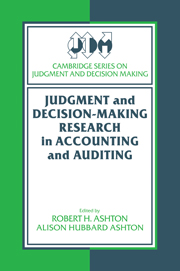Book contents
- Frontmatter
- Contents
- Contributors
- Series Preface
- Preface
- Acknowledgments
- Part I Overview
- Part II Judgment and decision-making research involving users of accounting information
- Part III Judgment and decision-making research involving auditors of accounting information
- 6 Judgment and decision-making research in auditing
- 7 The role of knowledge and memory in audit judgment
- 8 Research in and development of audit-decisions aids
- Part IV Conclusion
- References
- Index
8 - Research in and development of audit-decisions aids
Published online by Cambridge University Press: 03 May 2010
- Frontmatter
- Contents
- Contributors
- Series Preface
- Preface
- Acknowledgments
- Part I Overview
- Part II Judgment and decision-making research involving users of accounting information
- Part III Judgment and decision-making research involving auditors of accounting information
- 6 Judgment and decision-making research in auditing
- 7 The role of knowledge and memory in audit judgment
- 8 Research in and development of audit-decisions aids
- Part IV Conclusion
- References
- Index
Summary
The auditor's judgment process has been subjected to extensive study since Ashton's seminal work in 1974. In general, the results of audit judgment research are consistent with those of prior psychological research, including findings related to the lens model, heuristics and biases, memory, and expertise. The chapters in this book by Solomon and Shields (Chapter 6) and Libby (Chapter 7) discuss this literature. Much of this research suggests that audit judgment can be improved through the use of decision aids. The purpose of the present chapter is to review and analyze the research in and development of decision aids in auditing.
The chapter is organized as follows. The first section provides a background for the ensuing discussions. The second section discusses motivations for developing or using decision aids. The third section discusses potential effects of audit decision aids on individual judgment and auditing firms. The fourth section categorizes the types of audit decision aids, while the fifth section reviews research on audit decision aids. The sixth section discusses the development of decision aids by auditing firms. The last section proposes areas for future research.
Background
Auditing is the process by which an auditor accumulates and evaluates evidence about quantifiable information (e.g., financial statements) related to an economic entity for the purpose of reporting on the correspondence between the entity's quantifiable information and some established criteria (e.g., generally accepted accounting principles) (American Accounting Association, 1973).
- Type
- Chapter
- Information
- Judgment and Decision-Making Research in Accounting and Auditing , pp. 207 - 228Publisher: Cambridge University PressPrint publication year: 1995
- 49
- Cited by



